You’re having a conversation with a friend, and you notice his speech is a little slurred. Should you be concerned? Yes … and don’t hesitate to seek medical help for your friend. Slurred speech can be an indication of a serious medical problem, especially if it’s accompanied by other symptoms.
It’s time to see your doctor if you have slurred speech and:
- Muscle weakness or clumsiness
- Fatigue
- Blurred or double vision
- Numbness or tingling
- Incontinence
- Impotence

This combination of symptoms could indicate you have multiple sclerosis, a disorder of the nervous system. It usually begins in early adulthood.
- Paralysis on one side of your face
- Loss of taste on affected side of your face
- Earache on affected side of your face
- Numbness on affected side of your face
If you have these symptoms, your slurred speech could be caused by Bell’s palsy, a paralysis of your facial muscles that is usually temporary.
- Headache
- Blurred vision or double vision
- Dizziness
- Weakness in your arms or legs
It is possible you may have had a mild stroke, or you may be experiencing a transient ischemic attack (TIA). This temporary brain disturbance usually clears up within 24 hours, but it is a warning sign that something is wrong. See your doctor immediately.
Immediate help for stroke
Don’t delay getting help if you have any of the symptoms of a stroke. The sooner you get help, the better your chances of survival without permanent brain damage.
When you have a stroke, the blood supply to your brain is cut off, either by a blockage of blood flow or by a blood vessel that ruptures and bleeds. When the blood supply to your brain is cut off, depriving it of the oxygen it needs, brain cells die.
A stroke that is caused by a blockage is called an ischemic stroke. It is the most common and, fortunately, less deadly type of stroke. Ischemic strokes can be caused by a blood clot that forms in your brain or neck (thrombosis), by a blood clot that forms elsewhere in your body and moves to your brain or neck (embolism), or by a severe narrowing of an artery that won’t allow blood through (stenosis).
A stroke that is caused by bleeding into the brain or the area surrounding the brain is called a hemorrhagic stroke. These strokes are more often fatal than ischemic strokes. They are sometimes caused by a ruptured aneurysm — a weakened spot in an artery that bulges outward.
A drug recently approved by the FDA to treat people suffering from strokes makes recovery more likely. This drug, tissue plasminogen activator or tPA (trade name Activase), dissolves blood clots that cause strokes. This will help people who have had an ischemic stroke, but not people who have had a hemorrhagic stroke.
For tPA to be most effective, it must be given within three hours of the stroke. One study found that 12 percent of stroke victims who were given tPA were soon back to normal. These people might otherwise have suffered a lengthy period of disability as a result of their strokes.
Since tPA is a relatively new treatment for stroke, your hospital might not administer it unless you ask for it. It could mean the difference between an independent life and months spent in a wheelchair.
The long-range plan for stroke
Half a million people a year deal with the potentially fatal or crippling effects of stroke. To keep this from happening to you, practice prevention. Don’t let a stroke take away your independence or your life.
- l Control your blood pressure. High blood pressure increases your risk of stroke. If you can keep your blood pressure under control, you may avoid a potentially fatal stroke. Your doctor can give you medicine to control your blood pressure, and if you watch your weight, exercise, and limit your salt intake, you should be able to lower the boom on high blood pressure and stroke.
- Chuck the cigarettes. Smoking contributes to a build-up of fatty substances that can block the main artery that supplies blood to your brain. This type of blockage is the leading cause of strokes in the United States. If that doesn’t convince you, consider that the nicotine in cigarettes raises blood pressure, another risk factor for strokes; the carbon monoxide in cigarettes reduces the amount of oxygen that your blood can carry to your brain; and smoking makes your blood thicker and more likely to clot. Kicking the habit isn’t easy, but when you consider what smoking is doing to your body, it’s worth the effort. Your doctor can recommend programs or medications that may make quitting a little easier.
- Exercise. Regular exercise can reduce your risk of stroke substantially. Exercise helps to keep your blood pressure under control. One study from Yale University found that men who walked over a mile a day cut their risk of stroke in half.
- Take daily vitamin E and aspirin. Aspirin has long been recommended for its ability to keep your blood flowing smoothly. Research finds that a daily program of aspirin and vitamin E can reduce your blood’s “stickiness” in half. This makes stroke-causing clots less likely to form.
- Keep diabetes under control. Diabetes can cause damage to blood vessels, making you more likely to become a stroke victim, and if your blood sugar is high when you have a stroke, the resulting brain damage tends to be more severe. If you have diabetes, work to keep your blood sugar under control, and keep your stroke risk at a minimum.
- l Don’t ignore TIAs. Transient ischemic attacks are sometimes called mini-strokes. Although the symptoms may only last a short while, they are a warning sign that something is wrong. See your doctor — it could save your life.